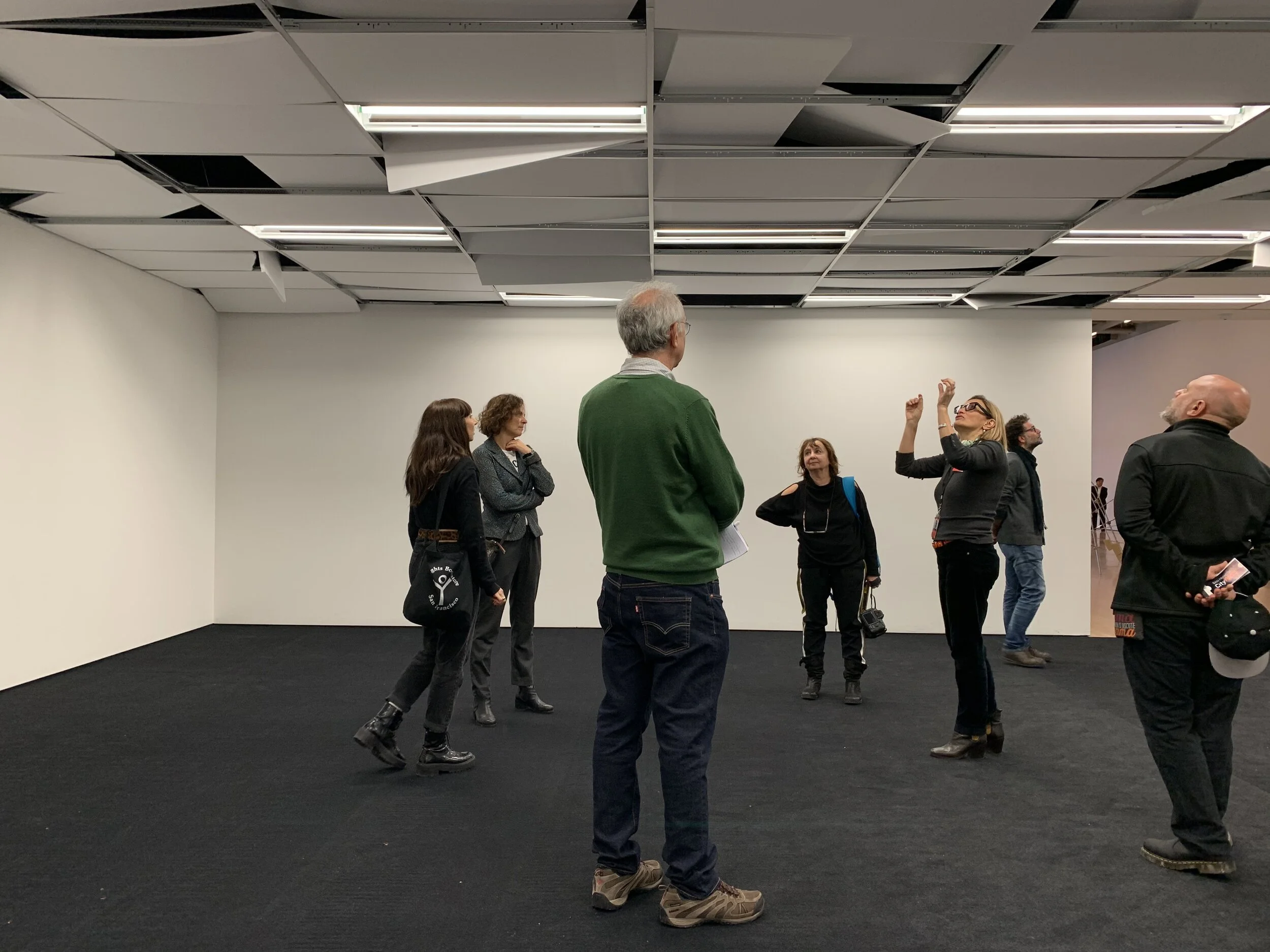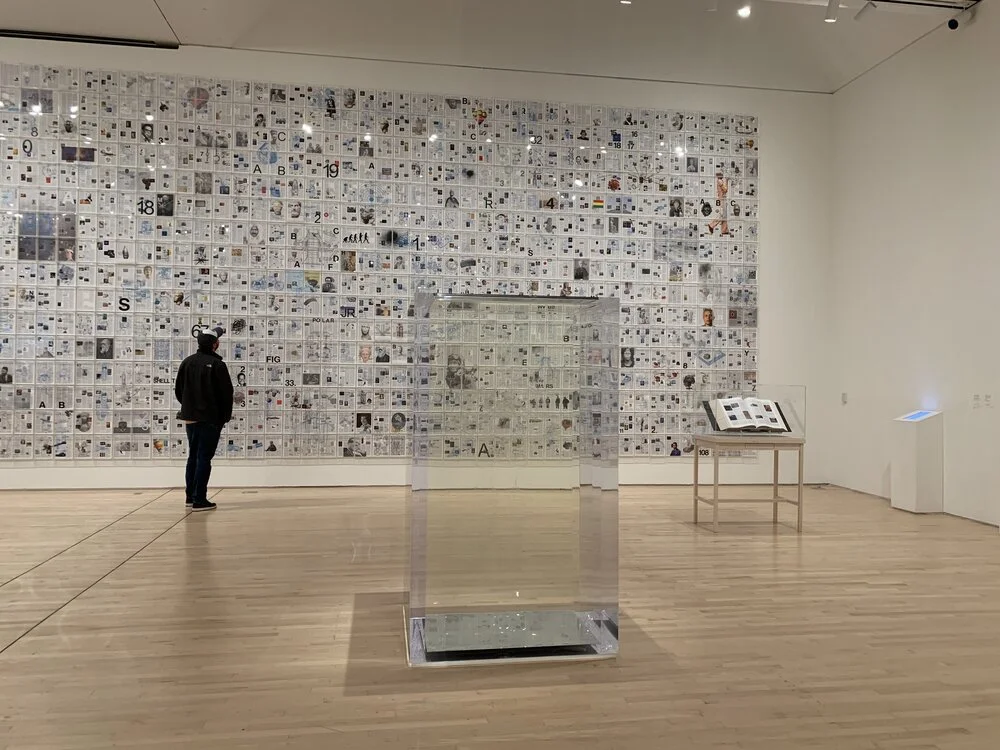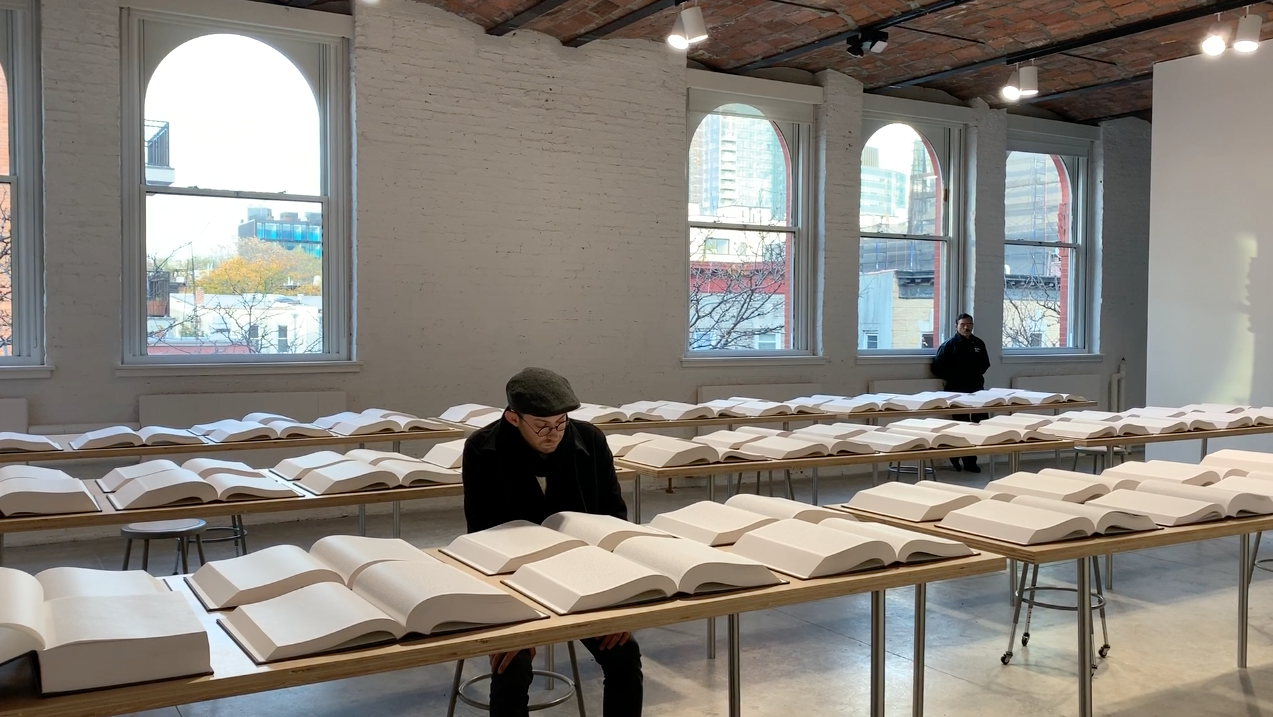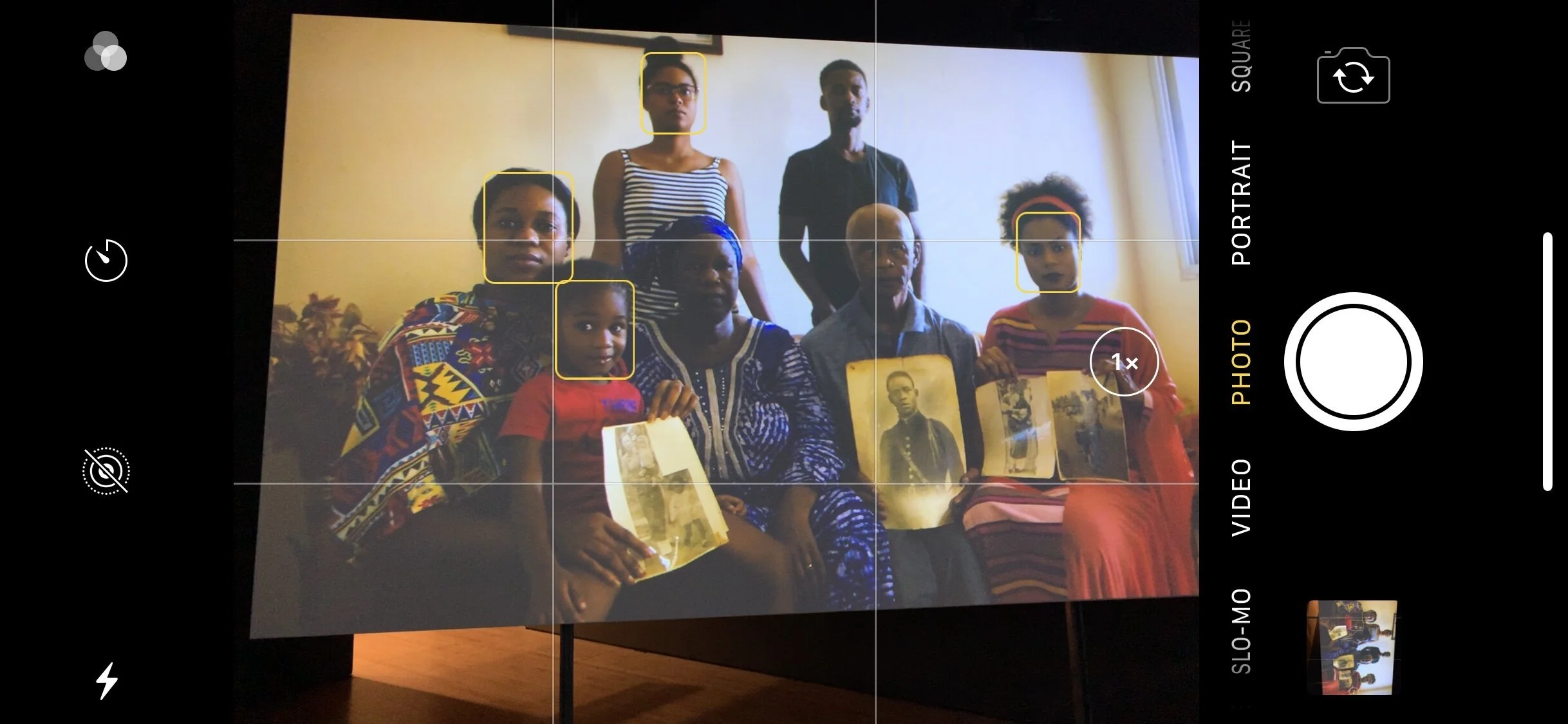Cinthia Marcelle’s There is No More Place in This Place 2019 on view in the exhibition SOFT POWER at SFMOMA, San Francisco October 26, 2019–February 17, 2020
Installation view of Tavares Strachan’s Encyclopedia of Invisibility, on view in the exhibition SOFT POWER at SFMOMA, October 26, 2019–February 17, 2020.
Installation view of Rachel Khedoori, Untitled (Iraq Book Project) (2008–2010) on view in the exhibition Theater of Operations: The Gulf Wars 1991–2011 at MoMA PS1, New York from November 3 to March 1, 2020.
Screenshot of an Iphone Camera’s facial recognition working on Tuan Andrew Nguyen’s The Specter of Ancestors Becoming 2019 on view in the exhibition SOFT POWER at SFMOMA, San Francisco October 26, 2019–February 17, 2020.
Installation view of Tanya Lukin Linklater’s The treaty is in the body 2017, on view in the exhibition SOFT POWER at SFMOMA, San Francisco October 26, 2019–February 17, 2020.
SOFT POWER Artists discussion at SFMOMA, San Francisco October 24, 2019
Installation view of Hassan Khan’s The Infinite Hip-Hop Song 2019, on view in the exhibition SOFT POWER at SFMOMA, San Francisco October 26, 2019–February 17, 2020.
Richard Mosse’s Incoming, on view at SFMOMA, San Francisco October 26, 2019–February 17, 2020.
Pratchaya Phintong’s A proposal to set CH4*5.75H20 on fire (work in progress), 2018 and Spoon, 2019 on view in the exhibition SOFT POWER at SFMOMA, San Francisco October 26, 2019–February 17, 2020.
SOFT POWER
An Italian speaking docent leads a tour through SOFT POWER, gesturing towards a drop ceiling falling apart, and says something I imagine is similar to the didactic text. The ceiling represents the patriarchy and it is broken. This factually sound and conceptually underwhelming conceit in Cinthia Marcelle’s There is No More Place in This Place, 2019 opens the exhibition on the first of two floors in SFMOMA.
SOFT POWER feels like an inaugural moment and a belated step towards the biennial-scale lingua franca of the contemporary art conversation, bringing with it the attendant problems of meaningfully engaging a fragmented set of issues, contexts, interlocutors and audiences. This is set against the attention economies from which it emerges and in which it competes, relevantly adjacent to Silicon Valley. The show commissions work from 20 mid-career artists or, as a banner on the front of the museum reads, 20 artists, 12 countries, 58 new works.
One feature of this now ubiquitous internationalist style of exhibition-making is the curator shopping the biennial circuit for a coterie of artists, who are presented in non-localized or lightly local-flavored contexts. Consequently, artists are grouped together in service of a curatorial vision ostensibly in urgent need of address, in ways prone towards overwhelming, superficially-explored sets of disjunctive concerns. ‘Soft power,’ a concept emerging in the Reagan-Thatcher era of neoliberal acceleration, suggests a power in art to achieve an unspecified goal—and presumably not as a speculative financial instrument, tax shelter, class signifier or wall decoration. On whose behalf this soft power is deployed, and to what end, in this context remains unclear.
Joo’s curatorial statement offers, “Perhaps we as a society have arrived at a moment that requires institutions to admit the soft power of artists and cultural producers as they usurp new opportunities for influence through a type of cultural diplomacy—as social media influencers, university professors and contemporary artists.” It continues “Taken together, the works presented in SOFT POWER inspire serious reflection on the historical legacy of conquest and domination as it has come to shape the rise and fall of economies, social organization, labor and migration. These are not distant topics or concerns. This exhibition assumes and welcomes a public with complex knowledge—an untapped source of energy ready to exert its own influence on the world.”
Are we to assume then that the telos of art (and power) is to influence? Perhaps if one were to offer a history of visual culture as inextricably linked from advertising’s imperative to capture attention, then a foregrounding of influence-as-power in the visual arts could seem orthodox. Within this curatorial framework, and throughout the show, questions about superstructural forms, including those of the institution, art market, internet age and their attention economies remained largely unexamined. This feels like a significant oversight considering the host institution is under the shadow of the Salesforce tower and a short Uber or private shuttle bus away from the most powerful technology companies in the world. The effects of Silicon Valley have ravaged the social and cultural landscape of the Bay Area while more broadly creating the conditions of a predatory and terrifying internet.
Manthia Diawara’s catalogue essay offers up a ‘solidarity of intuitions,’ to connect the work, drawing from Glissantian concepts. Glissants’ Mondialité offers a potential, though ambiguous, alternative to the homogenizing force of globalization, describing a poetics of relation that plays out with a mutual respect for each person's unknowable opacity and dignity. His conception of creolization or hybridity is used as a balm for an age of identitarian politics and nationalism, acknowledging the increasing intersectionality of the world. As is often the case with poetic and ambiguous thinking, it can find itself mobilized in service of many different kinds of ideologies. Encountering Glissant at the outset of SOFT POWER I had an uneasy feeling not unlike hearing Hans-Ulrich Obrist open his Prelude to The SHED in New York with a panel on Glissant’s Mondialité.
Much of the work in the show felt like the kind of imminently forgettable gallery fodder one could expect to fill the two giant SFMOMA floors it occupied, deploying a lot of scale on behalf of meager concepts. Tavares Strachan’s Encyclopedia of Invisibility is a tediously long collection described by his gallery as “...one person’s attempt to unravel the Borgesian web. Its fifteen thousand entries describe people, places, objects, concepts, artworks, and scientific phenomena that are hard to see and difficult to ascertain.” It was also Borges who wrote, “The composition of vast books is a laborious and impoverishing extravagance. To go on for five hundred pages developing an idea whose perfect oral exposition is possible in a few minutes! A better course of procedure is to pretend that these books already exist, and then to offer a resume, a commentary...” To which I would add something about the ecological disaster that is acrylic, which Strachen uses in enormous volume. That history is biased, contested and partial I understand to be a conception long put to rest and little is advanced by this gesture that re-invisibilizes these histories with a deluge of information and retrograde graphic design.
A persistent question facing curators addressing audiences with varying degrees of art-cultural-historical backgrounds is; to what level of depth and granularity does one explore a subject? The contemporaneous Theater of Operations: The Gulf Wars 1991–2011 exhibition at MoMA PS1 features 300 works from 82 artists, largely from Iraq and its diaspora. The show takes up the whole of PS1 and features an extensive film program, performances, panel discussions and print publications throughout its four month run. SOFT POWER, while more modest in size, features artists from a dozen cultural contexts, any one of which could be a lifetime pursuit of study. The handful of short reviews from some leading contemporary art journals feels incommensurate with the scope of the project, though maybe understandable in the context of waning attention spans and remuneration for critical writing.
The first couple weeks after the opening of documenta 14 there was a flurry of short reviews, many of which read as dismissive and unfavorable. This was troubling at the very beginning of a 163 day long art event bi-located in two cities with over 160 artists exhibiting at 82 venues, featuring daily performances, lectures, discussions, screenings and concerts—in addition to an international radio station, voluminous website, and at least several print publications. This overwhelming scale, consistent with the internet age, creates an impossibly large and unassimilable surfeit of culture to which cursory contempt and copy-and-paste press release journalism has become de rigueur on the consumption side. Meanwhile, attention garnering and social media-genic works have come to largely define the cultural production side. Throughout SOFT POWER, as is often the case, many of the works seem to assert themselves, almost in competition and using the same vernacular as advertising with its corresponding scales, media, durations, and frequencies.
One theme that emerged in SOFT POWER, is the problematic of speaking on behalf of an identity category, imposed or assumed. On one side of the 7th floor gallery Tuan Andrew Nguyen’s strikingly produced immersive four-channel video work The Specter of Ancestors Becoming (2019) depicted fictionalized intergenerational conversations exploring personal histories of unnamed and uncredited collaborators from the Vietnamese community in Senegal.
On the other side of the gallery, in a decidedly un-stylish and pedagogical installation, Carlos Motta’s LGBTQI Dreamers cedes its authorial voice over to its subject, Julio Salgado, who laments a Time magazine representation of undocumented people. Julio in turn voices his reservations about speaking on behalf of anyone else in a kind of infinite regress of ceding the power-of-platform, so as not to let an individual essentialize and represent a group identity formation.
At the outset of the fourth floor galleries is a piece by Tanya Lukin Linklater showing a muted video of an Omaskêko Cree knowledge keeper (Jennifer Wabano) learning together with a group of women and girls beside a vitrine that looks like something between a coffee table and a coffin with five Kodiak Alutiit sewing bags taken from an anthropology collection entombed, and essentially muted, within.
In contrast to Linklater’s silence, LaToya Ruby Frazier spoke at the artist’s talk with such compelling eloquence, authority and persuasion about her subject of reverse migration for black families after the Flint water crisis, it made me wonder if she wouldn’t be better suited as a politician. Her rhetorical abilities charged the conventional black and white photo essay with a sense of urgency.
When Glissant conceptualized mondialité I imagine he wasn’t picturing a group of 20 artists sitting uncomfortably in a circle on proscenium stage brought together under the auspices of ‘soft power’ with major support provided by Shawn and Brook Byers, the Ford Foundation, Diana Nelson and John Atwater, Katie and Matt Paige, Helen and Charles Schwab, Sabrina Buell and Yves Béhar, Sean Leffers and Tom Buttgenbach, Sir Deryck and Lady Va Maughan, Aey Phanachet and Roger Evans, Alka and Ravin Agrawal, Fundación Botín, Dolly and George Chammas, Wayee Chu and Ethan Beard, Oya and Bulent Eczacibasi, and the Friends of Contemporary Art at SFMOMA. A light google will quickly expose some of the reprehensible people and practices underwriting this endeavor. Perhaps another perspective on this kind of exhibition-making could be formulated as how does one understand and evaluate the increasingly indistinguishable forms of biennial, art fair and international museum survey in the light of its not-so-distant past of colonial horror shows, ethnological exhibitions and human zoos, organized by an indefensible elite and reflecting their values? These questions proceed and accompany the machinations of the art market, an unregulated trillion dollar space of speculative capital with a suite of instruments exceedingly complex.
The format of the artist talk was introduced as an open conversation and it appeared many of the artists had only just become acquainted. Soon after the opening comments, artist Xaviera Simmons asked each of the other artists to say where they are from and what the current issue of most concern is there—or how is the place they are from being ‘disrupted?’ To this prompt the other artists offered a spectrum of responses with quite a few troubling the question. Hassan Khan in particular voiced his misgivings, feeling that he did not want to reduce the situation in his former Cairo to something disseminable in this kind of format. He identified himself as something like an internationalist, operating in a peripatetic art context. Duane Linklater responded in Cree. Eamon Ore-Giron offered that soft power might be ‘a pirated CD or USB that you buy in a tianguis in Mexico City and you find a Peruvian cumbia that’s been slowed down by a Mexican in Monterey.’ Tuan Nguyen stated that he would prefer not talk about Vietnam but would rather talk about the last month and a half he spent working with an Indigenous tribe in Western Australia who are experiencing extraordinarily high suicide rates. Prachaya Phinthong mused about a recent trip to Kolkata researching a dam on the Ganges built 40 years ago, blocking the migration patterns of a local fish. The dam was slated to reopen and he was curious how the fish would respond.
After all the artists had replied, Simmons asked Khan if he would elaborate on his discomfort with the question and joked that they could go toe-to-toe. Khan reiterated that he felt more international than of a particular place and went on to say that North America felt disconnected from a global dialogue. He felt it was important to critique the institution, grazed the subject of identity politics and concluded he was unresolved in his thinking. Simmons replied that they were here (in the US) and reproached him for appropriating hip hop in his work. The conversation flared up into a tense register, replete with call-outs, privilege-checks, bullying and shaming before the subject was abruptly changed to another artists work and another cultural context. The talk had the rhythms of social media, soundbytes of information and virtue signaling concerning disparate subjects with light affirmative or polemical commenting in a rapidly shifting sequence of non-sequiturs; the groups position in a closed-circle on stage allegorizing algorithmic echo chambers.
There was not much in the show that felt particularly addressed to San Francisco, with the exception perhaps of Hassan Khan’s algorithmic hip hop piece that took a library of dubious-quality hip hop fragments as source material for an never-ending array of AI-determined variations. If the cautionary here is that AI systems inherit their creators’ biases and limitations, the interminable hours of unlistenable hip hop belabors the point that we don’t want to live in the artificially intelligent hellscapes being designed by Silicon Valley.
In an adjacent gallery to the SOFT POWER show was Richard Mosse’s dramatically scored three-channel video work shot with military grade, extreme telephoto thermal optics, focused on people living in refugee camps. The result is a hauntingly inhuman gaze that complicates and contemporizes this persistent condition. While I tend to resist the aestheticization of humanitarian crises at the spectacle scale in contemporary art settings, the result here was a chilling and immersive confrontation with the highly-militarized condition of life for an increasing number of the world’s population. If we continue looking though Joo’s curatorial lens, does this become an example of using hard power softly?
If we trace ‘soft power’ to its conception by Joseph Nye, it codes for a liberalism associated with late 20th century American foreign economic policy. It suggests the persuasive and co-optive counterpart to the military force of American imperialism and makes it unclear how to view Jason Moran’s piano paintings under Joo’s conceptual rubric. As is often the case with surveys at this scale, visitors are given an overwhelming range of considerations from which to make their own connections and departures and one can end up in the confusing position of simultaneously trying to reconcile questions like ‘what could autonomy in Rojava mean?’ with ‘does Louise Bourgeois do her own taxes?’
I find myself feeling both culturally obese and still hungry, with no one to mondialité with. From my position in the San Francisco Bay Area, a part of the world that has consolidated such an overwhelming amount of power by ‘innovating’ ways to surveil and exploit people on the internet, I’d like to see more artists and curators taking on these issues in critical and nuanced ways, with spaces for discussion. As far as surveys of contemporary international art, SOFT POWER reads as regressive, thematically beside the point in its context, and failing by its own logic to address the questionable premise it puts forward. Be that as it may, there is still a lot to consider from this work brought together under Joo’s curatorial power.
The work from SOFT POWER that most impressed me was by Pratchaya Phinthong. Less than feeling persuaded by someone seeking power, the work opened up poetic spaces of contemplation that felt commensurate with a globally connected world. In Give more than you take (2010), as Pratchaya worked as a seasonal berry picker in Swedish Lapland, he requested a museum director in France to display the corresponding weight of berries he picked with out-of-use office supplies in the galleries. In the SFMOMA installation he showed a corresponding film, a hunting tower he dismantled alongside the other precarious seasonal workers, and the same weight in Californian walnuts. In A proposal to set CH4*5.75H20 on fire (work in progress) a 16mm film projector—itself a reified form of advanced ideology and economic processes—projects a flickering alternative energy source and potential imaginaries in quiet conversation. In A whole from a different half (2018), a charcoal wall drawing and accompanying didactic text reference the Mother’s Womb Cave, a sacred Buddhist site in Mongolia where it is believed that completing a somersault within assists in spiritual rebirth. Phintong brought a small sphere of Yttrium – a rare earth used in smartphone production – as a gesture of restitution to the site before performing a somersault. The charcoal drawing itself is a material reference to the pollution in Mongolia, further explicating the effects of runaway extraction. Spoon (2019) comes from a collaboration with villagers in Napia, Laos, who have been collecting undetonated U.S. bombs and melting them down into spoons to sell to tourists. Phintong asked them to create free-form reflective circles, which allude to metal’s liquid state, which he paired with postcards mirroring the villagers hands laboring in bomb-cleared land converted to cotton fields. In each of these works a conceptual horizon was opened through system-level interventions performed across media and actors, and towards which I continue to return.



